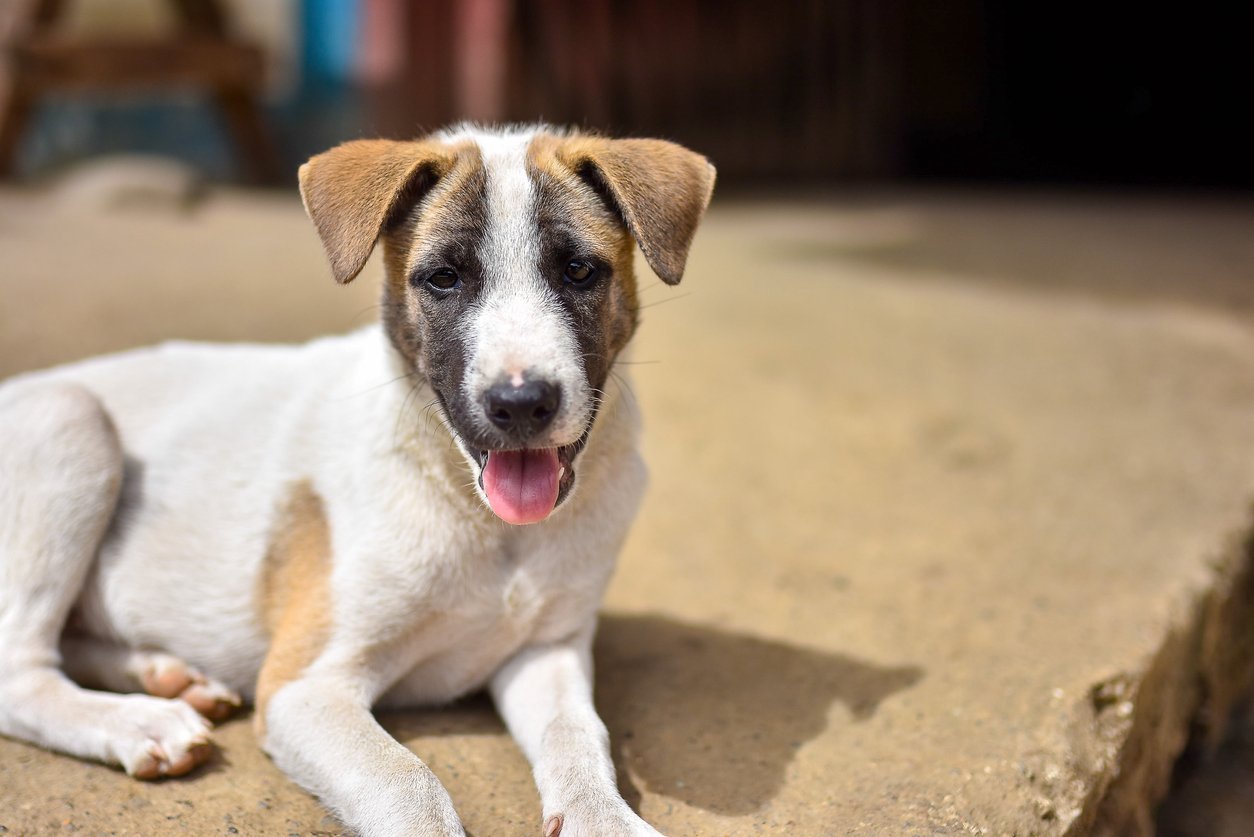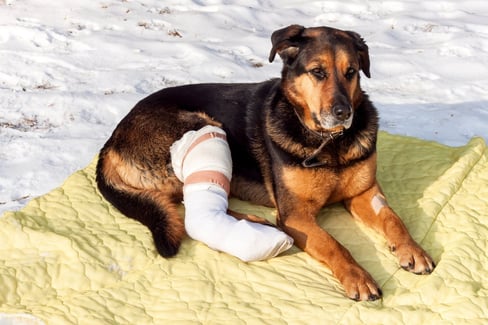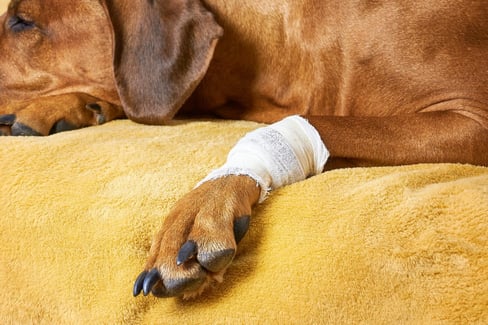Table of Contents
Running, jumping, playing. Catching their favourite frisbee. Rolling around and playing tug of war.
These are all things that your dog dreams of doing. Dogs that are, by nature, curious and active furballs.
But what happens when they are stopped in their tracks by a painful and sudden (it may seem) injury?
Not so fun.
Help protect your dog from one of the most common and painful injuries for your pup – a dog ACL tear. ACL dog tears can be sudden, or can slowly develop over time, leading to eventual injury. This integral ligament needs to be maintained to prevent injury, and when pain sets in, you need to know exactly what to do.
Let’s break down the important facts about dog ACL injuries so your pup can avoid this ruff injury.
What Is an ACL in a Dog?
The ACL on a dog is an important ligament in their stifle (knee) joint. The ACL in dogs is called the cranial and caudal cruciate ligaments (CCLs). Cruciate ligaments are named so for their function of crossing over something or forming a cross; in the case of the dog’s ACL, the cross is over the femur and tibia. A dog’s ACL is a fibrous band of tissue that connects the bones above and below the knee joint to allow the joint to work as a hinge.
It is essential for movement. Without the ability to hinge at the knee joint, your dog cannot run, jump, or even walk. This reduces their quality of life significantly and doesn’t heal on its own, so you need to address it right away.
Dog ACL Anatomy
Ready to become a dog ACL anatomy expert?
Understanding how the dog’s ACL functions are critical to preventing injury in the first place.
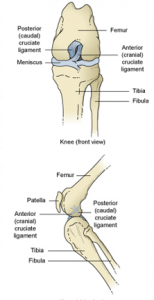
The dog ACL, or CCL as noted in the diagram above, connects the femur and tibia at your dog’s stifle, which is their knee. These two long, important bones need to be joined together somehow in order to function as a hinge, allowing your dog to move forward and backward.
As we mentioned, these ligaments are like a cross. A ligament runs from the inside of the knee to the outside, and another from the outside to the inside, crossing over each other in the middle. These two ligaments are called the cranial and caudal cruciate ligaments, as seen in the diagram above. For dogs, the most common injury to the stifle is a rupture of the cranial cruciate ligament, rather than the caudal cruciate ligament.
We often call the CCL the dog ACL. While humans do have a similar anatomical structure in our knee, these ligaments are called the posterior and anterior cruciate ligaments. Like humans, your pup is more likely to experience an anterior cruciate ligament dog rupture than a posterior one.
Types of ACL Injury Dog
Like many kinds of injuries, an ACL injury in dogs can be either:
- Chronic
- Acute
Chronic, referring to the long forming and slow onset of dog ACL injuries, is more common than acute dog ACL injuries, which happen instantaneously with no prior damage to the ligament.
In this section, we’re going to break down the differences between these two types of dog ACL injuries so you can spot the signs of both with ease.
Chronic ACL on Dog Leg Injury
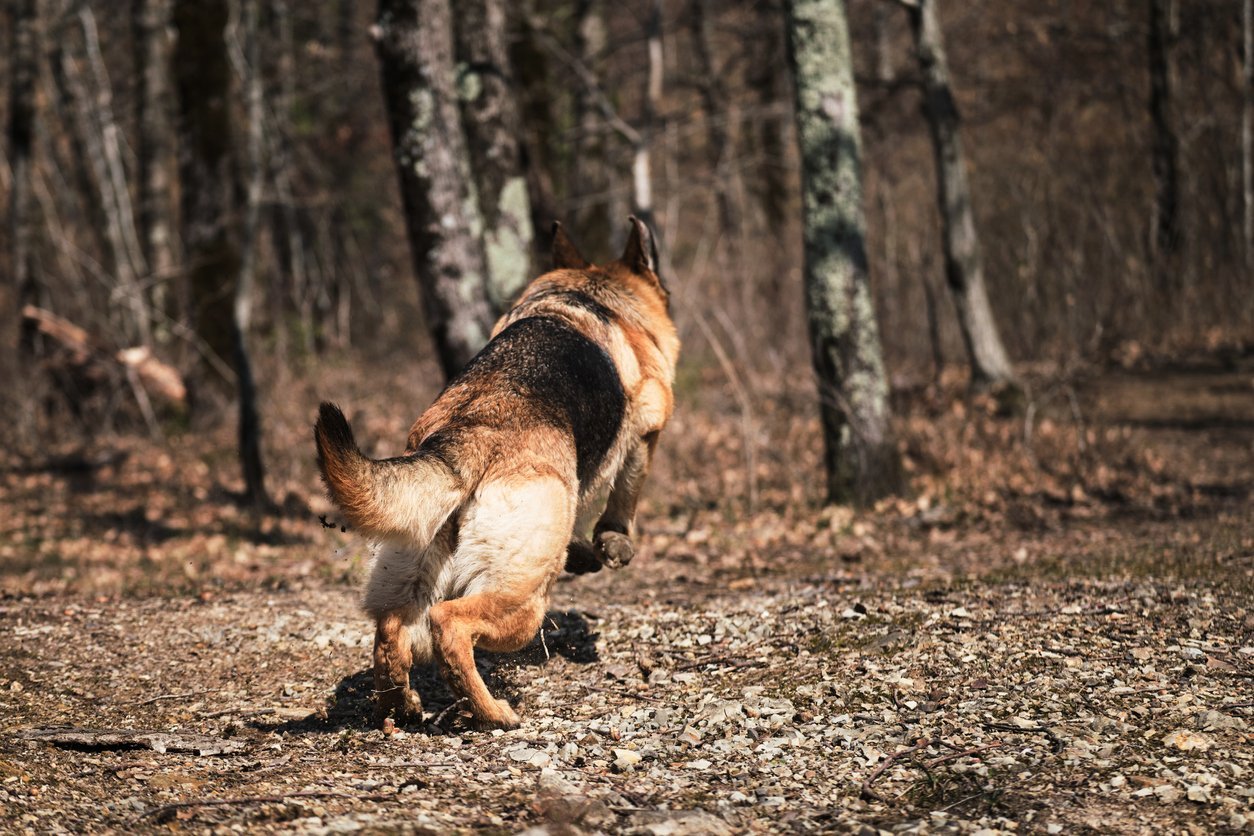
Did you know that 80% of dog ACL injuries are defined as chronic?
Slow degradation over time is one of the biggest reasons that a dog’s ACL ruptures, and is definitely more common than its acute form. Chronic torn dog ACLs commonly occurs in dogs five to seven years old, and although this is a common occurrence, we’re not quite sure why exactly it happens in the first place. It is thought that a chronic dog ACL injury is a multifactorial disease, meaning it can be caused by a number of factors together.
A chronic ACL on dog injury can be a full or partial tear dog leg injury. A complete tear is a rupture of the ligament, meaning no fibres are attached anymore, and the ligament is not intact.
In contrast, a partial tear occurs when some fibres tear, but the ligament remains intact overall.
Torn fragments cause inflammation in the joints, which leads to the eventual breakdown of the partially intact ligament. This is known as degenerative joint disease, and it causes poor pup pain and stiffness in the joint and surrounding soft tissues. Moreover, the ligament cannot heal itself due to its insufficient blood supply. Therefore, surgery may be necessary to correct the tear and restore your dog’s quality of life.
The key factors that can contribute to chronic ACL injury dog are:
- Breed
- Activity level and weight
- Age
In terms of breed, there are a few breeds that seem to have a higher propensity to developing a chronic or partial torn dog ACL:
- Bichon Frise
- German Shepherd
- Labrador Retriever
- Newfoundland
- Rottweiler
- Saint Bernards
You’ll notice that most of the breeds listed are large or giant breeds. Due to their size, dogs like these can be susceptible to dog ACL tears, as well as other joint-related issues like hip dysplasia. That doesn’t mean that a small dog torn ACL is impossible, though. It is thought that there are some genetic or breed-specific traits that cause dog ACL tears to be more prevalent in some breeds over others, and sometimes our little companions are simply more susceptible to injury due to their small size.
Dogs that get infrequent, sporadic strenuous exercise and are obese are also more likely to sustain dog ACL injuries. Think of it like deciding to run a marathon with no training. Their increased body weight puts more weight on their joints and can degrade the ligament more quickly. As the dog’s ACL becomes more damaged over time, these chronic conditions persist for long periods, with the dog gradually becoming lame. However, in some dogs, your pooch will show no signs of pain until the ligament ruptures, sometimes due to something as straightforward as a slight slip when you’re walking.
When it comes to age as a factor for dog ACL injuries, data has shown that on average small breed dogs are eight years old, and giant breeds are seven years old when dog ACL injuries occur.
That means middle-aged dogs seem to be at the highest risk for developing a chronic dog ACL injury; though young dogs can be susceptible to dog torn ACLs, it’s more likely they will experience an acute or sudden rupture.
Acute Dog Knee ACL Injury
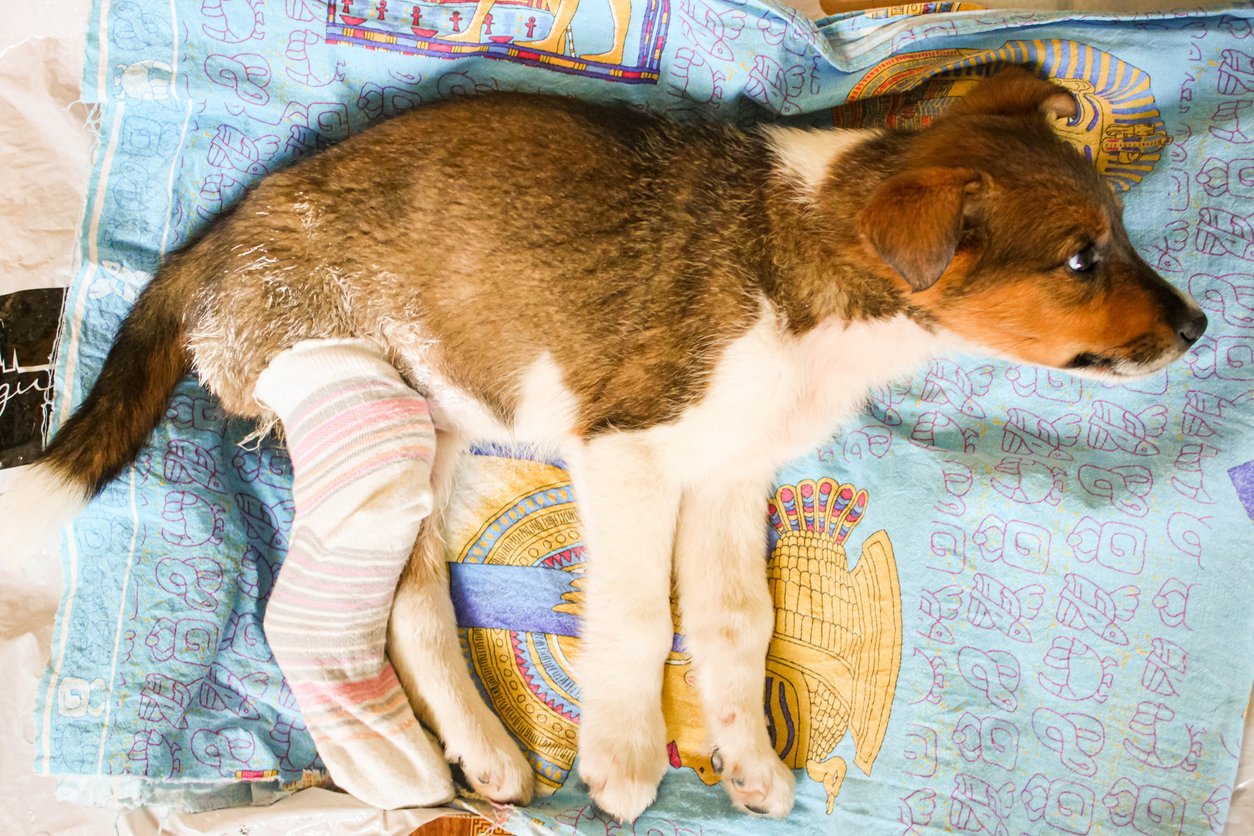
Have you ever experienced your pet, or maybe even yourself, halting from a sudden injury? The freeze, the drop to the ground, the inability to move – it’s pretty scary stuff.
This is an acute injury. It happens suddenly, with no prior indication it would happen. Acute cruciate ligament tears happen most often due to a sudden twisting motion in the knee and primarily affect the ligament at the front of your dog’s knee, the cranial cruciate ligament.
Most often, this happens when the dog is running and suddenly changes direction. Due to this, most of the body weight is placed on the knee joint, where excessive rotation and tearing forces are placed on the cruciate ligaments. A dog ACL rupture can cause tremendous pain and instability to the knee joint, resulting in lameness.
Canines that are overweight may be at greater risk of suffering a sudden dog ACL rupture. The heavier they are, the more weight that bears down on their joints, and when a force of any amount is involved, it can result in a painful injury for your pup. Additionally, dogs with other knee problems such as a luxating patella may also be predisposed to rupturing their cruciate ligaments due to existing structural or injury-related problems.
3 Reasons You Should Maintain Dog ACL Health
It’s absolutely essential to maintain dog ACL and dog joint health.
But why exactly should you maintain this important ligament with preventative care?
The short answer is that you need to maintain your dog’s ACL health to prevent them from:
- A life of pain and discomfort
- Developing other degenerative orthopedic conditions
- Having to drop out of a sports activity
You don’t want your dog to have to experience those things, so let’s get into some more detail about each factor so you can better understand the importance of prevention.
Prevents Pain & Mobility Issues
Dog ACL injuries greatly impact mobility, mostly due to the pain caused by the inflammation in the ligament.
For chronic cases of ACL injury in dogs, the slow degradation of the ligament creates inflammation in the joint. This makes for painful movement, and you may notice your dog is limping or showing lame dog symptoms when they do move. Getting up from a seated position will also be a challenge for your dog. This is caused by an unstable and weakened knee that is becoming less functional as the ligaments degrade over time.
For acute cases of dog ACL injuries, the pain your dog feels will be immense and immediate. Imagine pulling a rubber band really tight. It can fling out of your fingers in an unpredictable instant, snapping and landing across the room. The ACL on dogs acts in the same way when it is ruptured. It is sudden, and shocking to your pup. Once it ruptures, it can’t heal on its own and will likely need surgery in order to restore your dog to some of its former mobility.
Unfortunately, no dog will ever return to its pre-rupture state even with surgery, meaning prevention is the only real way to keep your dog mobile and pain-free.
Reduce Likelihood of Orthopedic Problems
Sometimes, experiencing one illness or injury can lead to developing another. This can be because of a genetic predisposition, or physical factors such as favouring one leg over another and bearing weight unevenly.
In a review of torn dog ACL cases, it was found that 24.61% of dogs in the sample had orthopedic comorbidities, including:
- Arthritis
- Luxating patellas
- Elbow dysplasia
- Hip dysplasia
These conditions can develop after an injury like a dog torn ACL, leading to more pain and discomfort for your pup. Particularly, as a result of abnormal wear and tear between the bones and cartilage when a dog’s ACL ruptures, the knee joint develops arthritis. Depending on the severity of the injury, arthritis can be observed 1 to 3 weeks after the injury and will worsen over time. The result is chronic pain and loss of joint mobility.
Keeps Dogs in Sport
Your dog loves to participate in its favourite sport or activity. And for those dogs competing in agility and other dog sports, a torn dog ACL is a one-way ticket to early retirement.
Unfortunately, a torn dog ACL can never be fully restored to its natural state, meaning even if you catch the injury early and treat it appropriately, your dog likely won’t be able to participate in sports again.
If your dog is an agility champ – be warned. A dog’s involvement in agility, flyball, and other sports where your dog runs over hilly or flat terrain on a regular basis increases the risk of ACL tears.
3 Dog ACL Health Prevention Measures
You don’t want your dog to experience the pain and discomfort of a dog ACL injury. It can slow them down, and reduce their quality of life significantly.
That’s where prevention comes in. By following some simple preventative measures, you can reduce the likelihood that your pooch will experience a torn dog ACL.
Dog Joint Supplements
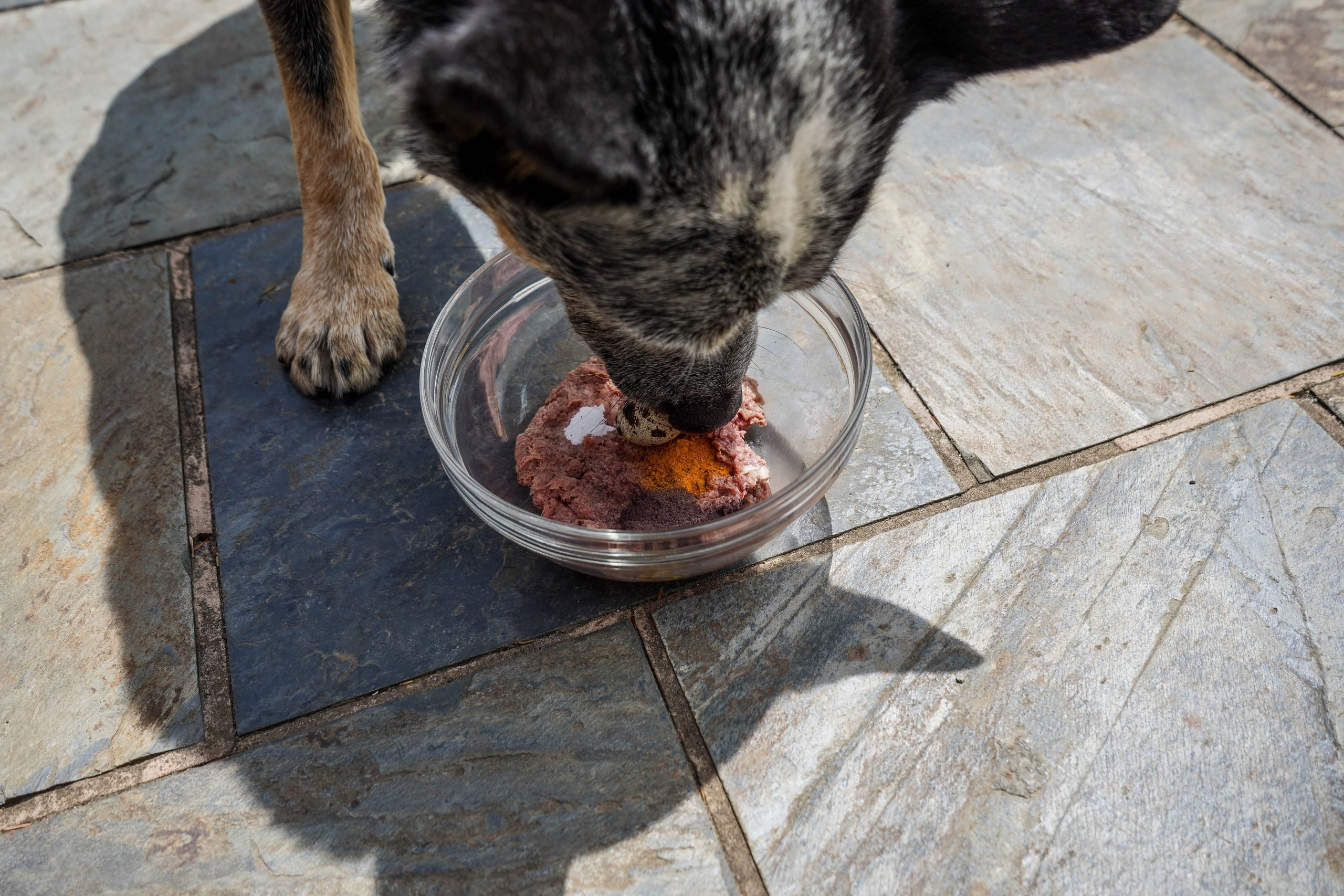
We’ve said it before, but we’ll say it again — you simply cannot guarantee that your dog will be able to avoid a dog ACL injury. In order to keep their joints and soft tissues healthy today and tomorrow, there is one thing you can do for them: include a joint supplement in their daily routine.
Joint supplements like Integricare’s TRI-ACTA help:
- Build strong joints, soft tissues, and ligaments
- Prevent joint degradation
- Reduce inflammation
- Improve mobility
By providing a joint supplement to your dog before they suffer an ACL injury, or before rigid joints begin to degenerate, your dog will have stronger, more elastic joints that can support active lifestyles. With healthier joints and ligaments, your dog will enjoy a better quality of life and you will be able to worry less about dog ACL injuries.
Before you choose a supplement for your dog, learn how to read a supplement label so you can choose the best option for your pooch.
The basics of what to look for in a supplement include:
- As close to 100% active ingredients as possible
- No fillers
- A small easy to serve dose
- Third-party batch tested ingredients
- Ingredients that support joint health (glucosamine, chondroitin, and MSM)
TRI-ACTA for pets checks off each and every one of those boxes, with the perfect amount of glucosamine for dogs paired with chondroitin and MSM in our regular strength formula. If you have a pooch who is already experiencing symptoms of a dog ACL injury, try our extra strength TRI-ACTA H.A, with the inclusion of hyaluronic acid for maximum joint health support and a boost to their mobility.
TRI-ACTA for Pets
A proactive approach for developing and younger adult pets to maintain optimal joint health mobility, minimize inflammation and fend off age-related ailments.
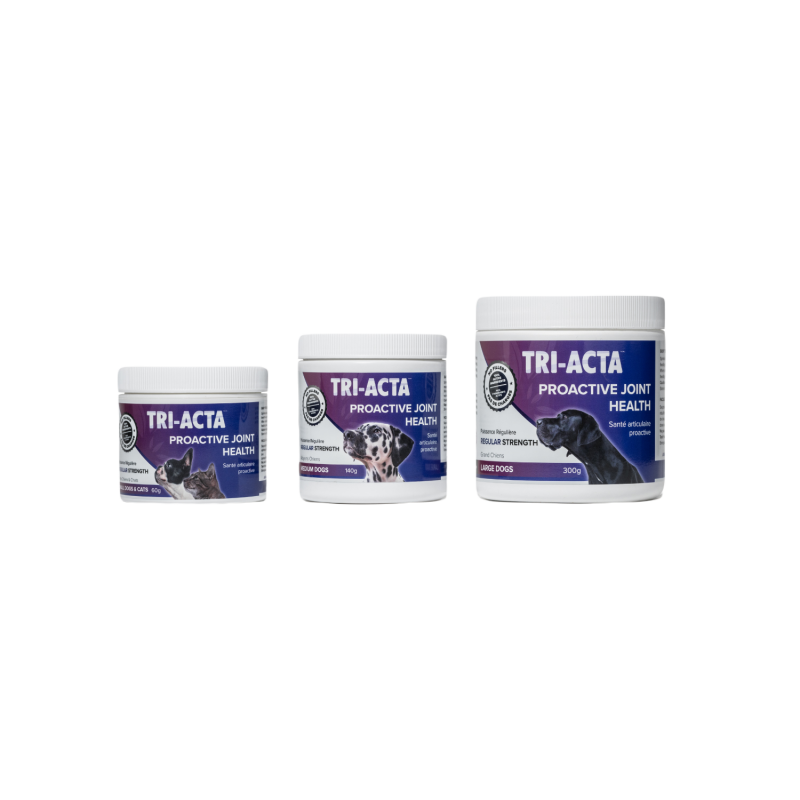
Exercise
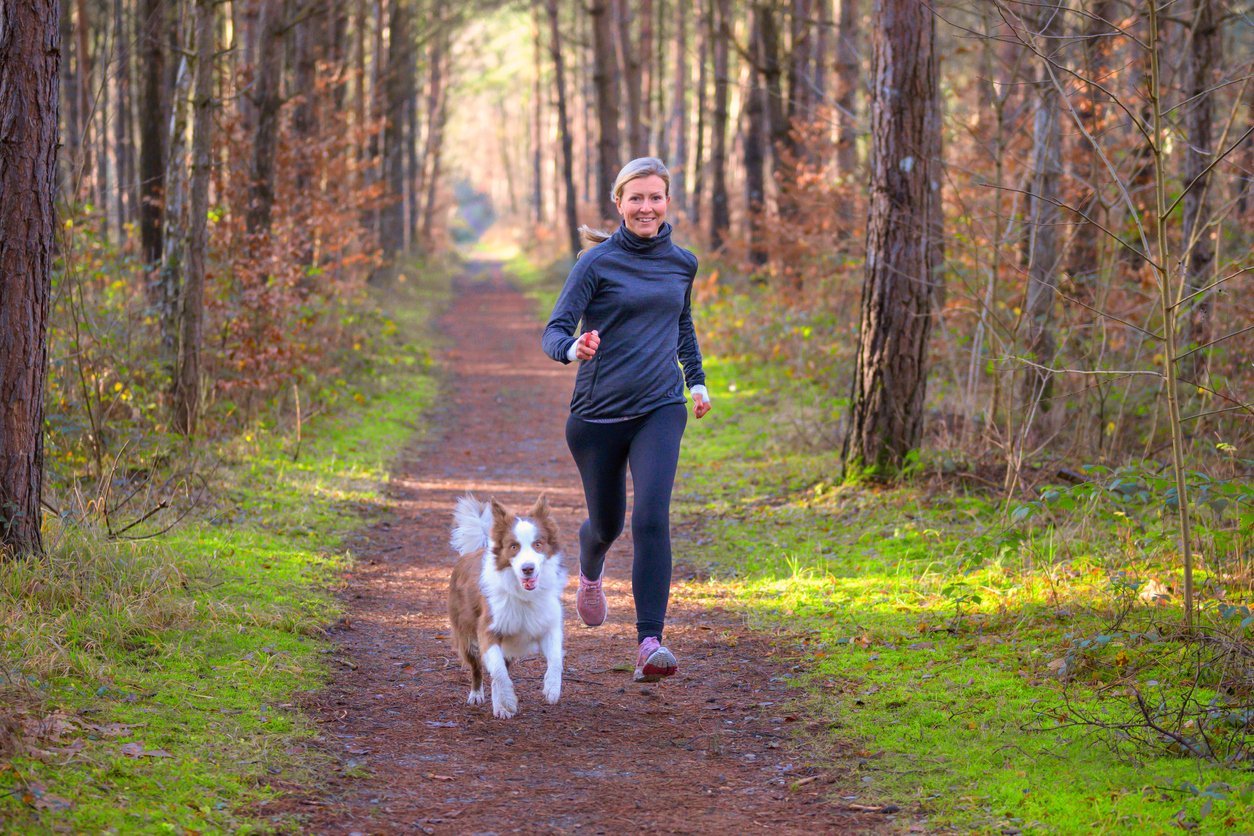
We know our pets love nothing more than a good nap!
But like us, your dog can have too much of a good thing.
Your dog needs to get exercise every single day to balance out those naps. Ideally, dogs should exercise for anywhere from 30 minutes to 2 hours per day. Ideally, this would be spread out over several activities. This might look like two, 25-minute walks per day rather than a 2-hour hike. These “weekend warrior” dogs can be most at risk for developing an ACL dog injury.
Your dog needs different types and amounts of exercise depending on both their age and breed. That’s because they have different fitness levels and needs at various times in their lives, and each breed has its own unique characteristics. While it might seem obvious that would be the case, it’s important to factor into an exercise plan for any dog especially those whose breeds are prone to ACL dog injuries.
The table below shows some exercise guidelines to follow that will help build a strong dog ACL and overall good dog muscle health at every stage of your dog’s life.
| Dog Life Stage | Key Consideration | Exercise Suggestions |
| Puppy |
|
|
| Young Adult |
|
|
| Mature Adult |
|
|
| Senior |
|
|
Balanced Diet
Creating a balanced diet is something that’s important for the overall health of humans as well as our furry friends. It can address everything from conditions like diabetes and heart disease to more ambiguous symptoms associated with ageing like dog limping.
A balanced diet can also help prevent dog anterior cruciate ligament injuries. That’s because each component in their diet builds healthy muscles and ligaments from the inside out. Most dog foods, especially senior dog foods, are formulated with the nutrient profiles your dog needs at various stages of their life. Often, these foods include enough of the minerals and vitamins your pup needs for basic maintenance, but adding a little extra to their diet in the form of a supplement or specialty dog food can help prevent injuries like a ruptured ACL in dogs.
Including the following in your dog’s diet build a strong and healthy ACL on a dog:
| Component of Diet for Healthy Dog ACL | Why it Matters |
| Omega 3 Fatty Acids | Promotes healthy growth and development and modulates inflammation because they are structural components of cell membranes |
| Glucosamine | Glycosaminoglycans are the building blocks of cartilage and joints, and dogs’ bodies produce less glucosamine as they age, so adding them back in can help keep soft tissues strong |
| Zinc | It Helps muscles work optimally during high-intensity exercise and help maintain the coat and skin of a dog |
| Manganese | Serving as an essential part of many enzymes, manganese also plays a role in bone and cartilage health. |
| Iron | Iron is a component of many enzymes, including those that produce energy. It is also a component of hemoglobin and myoglobin, which transport oxygen through the blood and muscles. |
Always consult your vet before adding anything into your pet’s diet, or if you are seeking a specialty diet to combat specific health issues, like a raw dog food diet.
Q&A
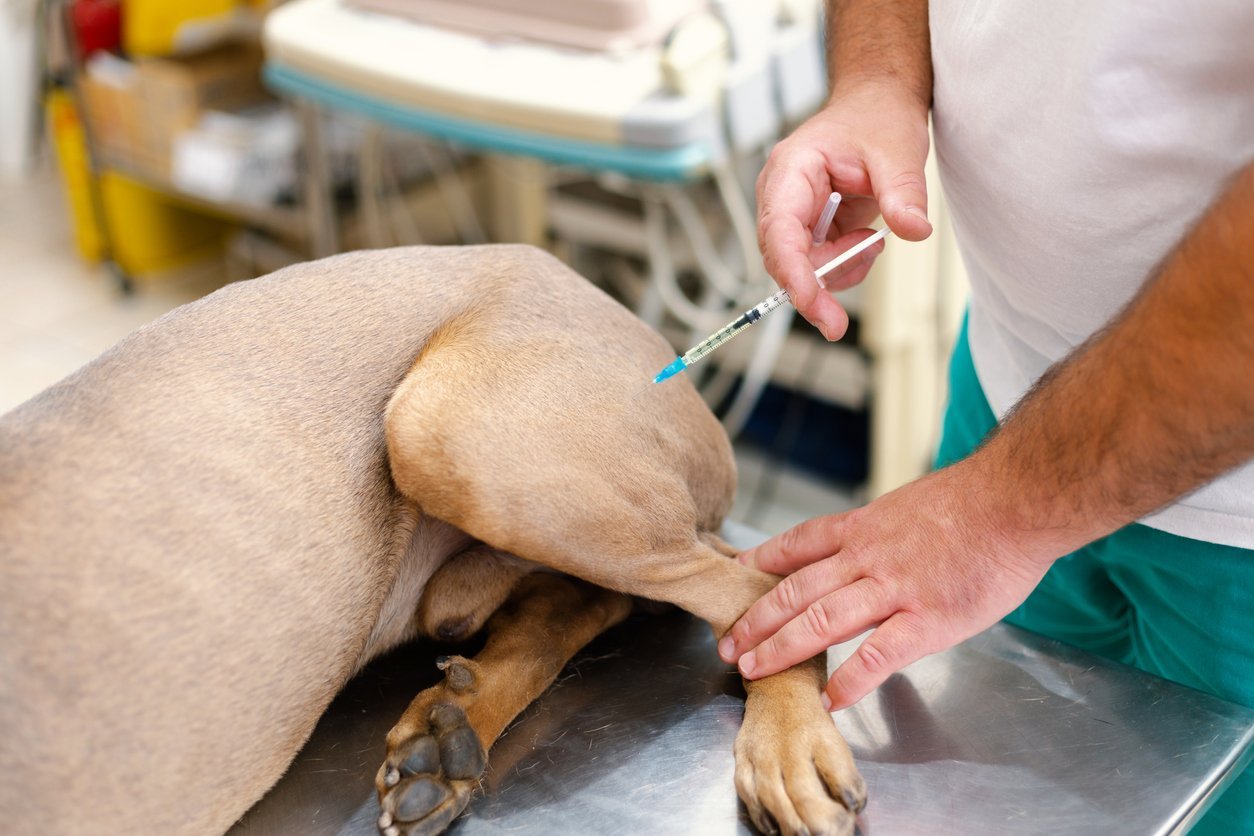
Can Dog ACL Heal Without Surgery?
A dog ACL cannot “heal” without surgery. Very small dogs weighing less than 22 pounds may be able to avoid surgery in the short term if given strict rest for more than 6 weeks. Unfortunately for both large dogs and any dog in the long term, surgery is likely needed to correct the injury and support their stifle.
No matter what size or age your sweet pup is, it can be a tough decision to decide whether to go with surgery or not. Often the degree of the injury is unknown until the vet begins operating on your dog, and it can also be extremely costly to undergo.
If you’ve got a sudden dog ACL injury, it is a good idea to start them on TRI-ACTA H.A., our maximum strength formula, right away regardless of whether surgery has been decided upon or not. In some cases, it may turn out that the injury can be managed without surgery.
If, after a few weeks, the injury appears significant enough and proceeding with surgery is decided as the best option, continuing the use of TRI-ACTA H.A. post-surgery can help expedite the recovery and reduce the chances of developing post-traumatic arthritic symptoms.
Where Is the ACL on a Dog?
The dog ACL location is in the dog’s stifle, connecting the femur and the tibia so that it can hinge, allowing your dog to move. In the middle of the knee, the caudal and cranial cruciate ligaments cross over one another, one going from the inside to the outside, the other from the outside to the inside.
Summary
Preventing an injury to your dog’s ACL means a better quality of life for them, and more time to enjoy the things you love doing together – running, playing, and exploring. Ensuring your dog has the right diet, exercise, and supplementation are all crucial to the success of prevention.
And when it’s time to add a joint supplement to their diet to support healthy soft tissues like the dog ACL and other important ligaments, choose Integricare’s TRI-ACTA for pets. Our formulas are high quality, highly effective, and are packed into an easy to serve, a small dose that has zero fillers. That way, you can rest assured your dog is getting all the joint health support they need, and none of the extra stuff they don’t.
Choosing TRI-ACTA o to help avoid dog ACL injuries means you’ll be setting them up for success. And in the event of an unfortunate ACL injury, TRI-ACTA H.A. isa key part of the recovery equation.
Find out where to buy our products, and learn more information about shaping a healthy life for your pets on our blog.
TRI-ACTA H.A. for Pets
Our maximum strength formula is optimally designed to accelerate the formation of cartilage, minimize inflammation, expedite the healing process, and improve joint conditions.

Newsletter Signup
Subscribe to our newsletter to receive the latest news and exclusive offers.
.jpg?height=2000&name=Cliick_Integricare-DISPLAY-REVISEDV2%20(1).jpg)
Proactive & Therapeutic Joint Supplements
When given daily, Integricare joint supplements recover bone and joint injuries faster and help prevent mobility injuries from happening in the first place.

